20 November, 2001
Most of the day was spent on science. It takes a lot of preparation and
planning to "do" science, which is part of the learning process. This
morning, Dr. Pawlowski and I put together gear and set up a tent to check
before taking out into the field this week. Plans are being made to melt a
dive hole near the Herbertson glacier (about one and half-hours away from
Explorers Cove by Ski-Doo), as a comparison study of forams with those at
Explorers Cove. Explorers Cove has an abundant population of forams. It
will be interesting to see whether other areas have a similar population,
especially in relation to the rare Astrammina rara, which is seldom found
in other places. I sorted foraminifera (forams) today, which require that
they be kept at a cold temperature at all times, less than 6 degrees
Celsius (< 42 degrees Fahrenheit). The specimens had to be kept on ice
while I sorted through a tray of these one-celled protists to find two
species: Astrammina rara and Crithionina. The organisms living within are
about one-half the size of the shell.
Astrammina rara is found on the bottom of the ocean in the top one
centimeter of sediment. The round shape and grains of sand make this
species easily recognizable. It is big enough to be seen without a
microscope, but a visor-type magnifier worn on the head helps a great deal!
These one-celled organisms attach sand to itself with a secreted "glue"
that adheres in a cold underwater environment. The Astrammina builds an
elegant spherical shell. What a surprise, especially since it is only
one-celled! (We have billions of cells in our bodies.) The Astrammina is
specific about the size of the grain it selects for its shell, but not the
type of grain. This foram species is apparently a "sit and wait" predator.
It doesn't appear to move around, but rather sits in the bottom
one-centimeter of sediment and extends its pseudopod "web" out around its
body. It will eat whatever lands in this branching mass of cell-stuff
(cytoplasm). The Astrammina rara will eat everything, such as microscopic
algae, bacteria, and baby marine organisms (starfish, worms, sea urchins).
Viewing Astrammina under a microscope only enhances the beauty of this
amazing one-celled organism.
Crithionina looks like a tiny mud ball. This little one-celled protist
doesn't secrete glue, but rather mud sticks to its surface as it actively
crawls through the sediment. It is a vegetarian. It doesn't eat marine
organisms, but it gobbles up algae in its path.
After sorting forams, I went to the "marsh" area to try the PASCO data
logger and temperature probe in this cold environment. The moat is starting
to melt, which enables me to collect hydrology (water) data, such as water
temperature and pH. I selected three sites to investigate. Site A is water
backwashed from the sea during the tide. Site B is fed by a runoff stream,
and site C is a pool of water near the transition zone (where the land and
sea meet). The water sites still have a thin layer of ice on the surface. I
have noticed that "site A" has an orange algae growing near the surface
under the ice. When I brought a small sample in to view under the
microscope, I noticed cynobacteria and a black sediment with a sulfur smell
under the algae.
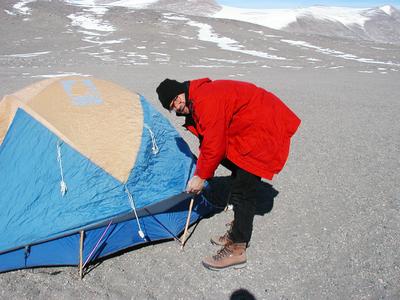
Dr. Pawlowski and I set up this tent to see if all the essential pieces were there. It is always important to check gear every time tents will be used in a remote area. This tent will be used for an upcoming trip to an area near the Herbertson Glacier. The tent will provide shelter against the wind over a two day period.
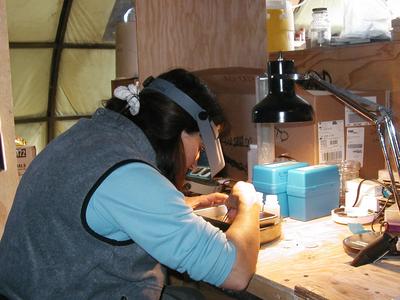
The magnification visor was very helpful as I sorted forams.
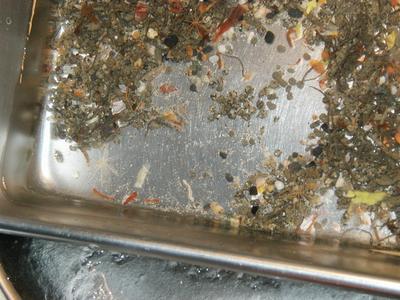
The tray of forams must be kept on ice in order to keep the forams alive. As I looked through this tray, I also noticed sea spiders, little bivalve shells, worms, and other microscopic organisms.

Dr. Alexander took a photo of an assortment of forams found here at Explorers Cove. The Astrammina rara surrounds the white spiral-shaped Cornuspira and two roundish-shaped Pyrgo forams. Foram species look different from the other. Magnifiers and microscopes are essential for sorting forams.

It is easy to make distinctions between the Astrammina and the Crithionina. Astrammina glues sand to itself, while the Crithionina looks like a little mudball.
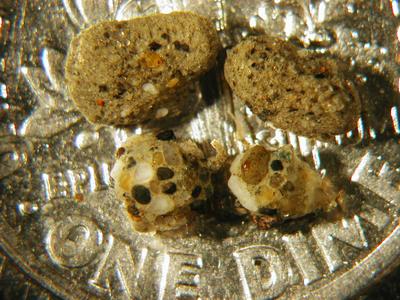
Dr. Alexander put the forams on a dime in order to give more perspective to the size of these forams.
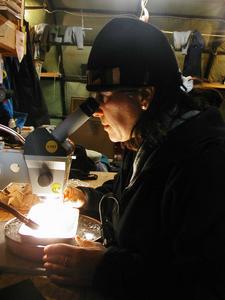
The microscope was a great aid in helping determine some foram species. The magnification gave an "upclose" view of the forams. It was interesting to get a closer look at the grains of sand that the Astrammina had selected to build its test (shell).
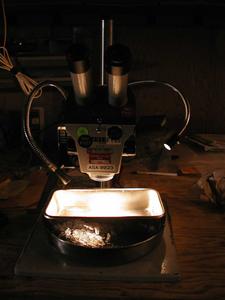
The tray was placed under the lighted microscope to help detect and sort forams. The microscopes are constantly being used in our field camp and in the Crary Lab.

Evidence of orange algae can be seen under the thin layer of ice at "Site A".

I have placed stakes at three water sites in order to take hydrology measurements. The water sites are in the moat "marsh" area near the Jamesway huts.
Contact the TEA in the field at
.
If you cannot connect through your browser, copy the
TEA's e-mail address in the "To:" line of
your favorite e-mail package.
|
